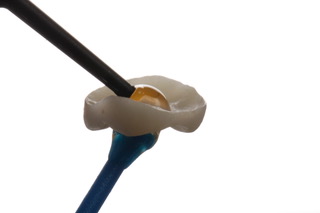As part of a year-long celebration to mark BISCO's 40th anniversary, we asked dentists to submit their best cases featuring BISCO products. We hope this case continues to inspire you and your team! To view all the cases selected and published click on BISCO's BEST: Cases to Inspire You
Case Study: The Overlay (Occlusal Veneer) Case Bonding Protocl
A conservative minimally invasive approach to preserve tooth structure.
Courtesy of Jorge Luna, DDS
Case Description: With this case, I took a conservative approach to preserving tooth structure using an overlay bonding restoration. A 42-year-old female patient came to my of?ce after receiving root canal treatment. Once the tooth was treated, cuspids were preserved to avoid possible fracture of the remaining structure. Cusps were prepped by reduction of 1 mm at the occlusal surface, a VPS impression was taken, and the dental laboratory milled a lithium disilicate overlay (occlusal veneer).
A rubber dam was placed, and the enamel surface was etched with phosphoric acid, rinsed with air/water, and the surface was gently dried. Two consecutive coats of
All-Bond Universal were applied and rubbed. The solvent was then evaporated with air and light curing was performed.
For the bonding stage,
eCEMENT dual cured resin cement was applied on the intaglio of the restoration. The restoration was delivered over the tooth surface, with gentle pressure applied, tack cured, then cleaned and flossed. Each tooth was light-cured. Glycerine gel was applied and light-cured. The rubber dam was removed and the restoration polished.

Figure 1: After try-in, the restoration is etched with HF acid.
Figure 5: The cemented restoration post-op.